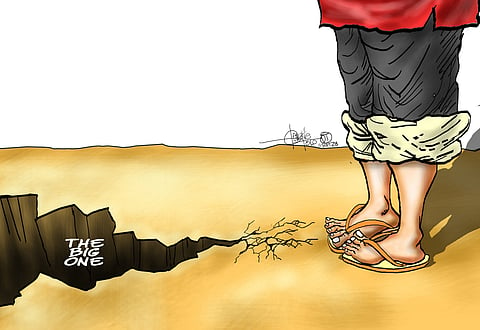

A devastating earthquake in Morocco has, as of this writing, claimed over 2,000 lives, with thousands more feared buried, dead, or barely hanging on to life beneath the ruins. The catastrophes in Morocco and previously in Turkey have sounded alarm bells across the globe, especially in countries prone to seismic activities.
One nation in fear of a massive earthquake is the Philippines, located within the Pacific Ring of Fire, a horseshoe-shaped belt of volcanoes and tectonic plates that encircles or cuts across the Pacific Ocean. The Ring of Fire is the most seismically active region on Earth and is home to more than 75 percent of the world's active volcanoes and the location of 90 percent of past earthquakes.
With the Pacific Plate subducting, or moving under, several other plates, including the North American Plate, the Eurasian Plate, and the Philippine Plate, the movement of the plates grinding against each other releases energy that can cause earthquakes and volcanic eruptions. In fact, the Ring of Fire is home to some of the world's most active volcanoes, including the Mayon and Taal in the Philippines, Mount Fuji in Japan, and Mount St. Helens in the United States.
The Philippines, in particular, has a lot to worry about regarding the West Valley Fault in Metro Manila, which has been dubbed a geological time bomb known as "The Big One."
In its recent findings, the World Bank has provided an alarming assessment of the potential consequences of an impending disaster, underscoring the urgent need for Filipinos and the Philippine government to bolster their preparedness.
According to the World Bank's risk assessment, "The Big One," a magnitude 7.2 earthquake along the West Valley Fault could result in a staggering 48,000 fatalities and economic losses estimated at $48 billion. These figures are not mere statistics but represent the grim reality that could befall the nation if proactive measures are not taken swiftly.
It said that beyond the loss of lives and the economic fallout, this catastrophic event could plunge Metro Manila into a state of chaos, threatening urban mobility, vital public services, and lifeline infrastructure, such as water and energy supply.
The West Valley Fault, running through multiple cities and provinces, has remained dormant for centuries, making it increasingly susceptible to a massive release of pent-up energy. With each passing year, the probability of a rupture becomes more imminent.
In order to mitigate an impending crisis, it is imperative to prioritize critical investments in emergency preparedness and response programs. One of the critical areas of concern highlighted by the World Bank is the healthcare system's ability to withstand the shockwaves of "The Big One." Hospitals must be fortified as lifelines for medical care to ensure they remain operational during and after a major earthquake.
This necessitates not only earthquake-resistant infrastructure but also measures to ensure accessibility when transport networks are inevitably affected. Hospitals must function seamlessly to cater to the surge in demand caused by the disaster while providing essential services to everyday patients and those with preexisting health conditions.
Furthermore, the World Bank's findings underline the vulnerability of the road network, with over 5,300 road segments intersecting the West Valley Fault at risk of significant damage and impassability.
Liquefaction, a phenomenon that deforms the ground and obstructs roads, poses yet another peril. Approximately 34 percent of Metro Manila's road network, covering over 7,000 kilometers, could be affected by liquefaction, the World Bank said. Access times may surge tenfold in these areas, effectively isolating communities and impeding crucial services.
The recent earthquakes in Morocco and Turkey have served as a wake-up call for countries prone to seismic activities, such as the Philippines. The World Bank's risk assessment of "Big One" is a stark reminder that the Philippines is sitting on a ticking time bomb.
The government and the people must take immediate action to bolster disaster preparedness and resilience. This includes retrofitting public buildings, including health facilities and schools, to make them more resilient against earthquakes.
It also includes conducting regular earthquake drills and simulations, educating the public about earthquake safety, and strengthening disaster communication and early warning systems.
The Philippines cannot afford to wait for "The Big One" to strike. Investing in disaster preparedness and resilience is not a choice but an imperative. Lives, livelihoods, and no less than the nation's future are at stake.
